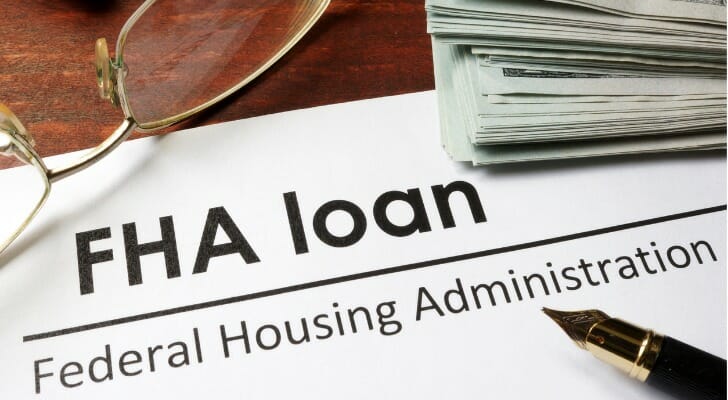Many first-time homebuyers will discover that they have to pay for something called “mortgage insurance.” This adds to your monthly mortgage payment and is often an unpleasant surprise. That’s particularly true if you sought out an FHA loan, which are structured for households with less money or weaker credit than those taking out a conventional mortgage. Fortunately, you can eventually remove FHA mortgage insurance from your monthly payments, but it may require refinancing if you’ve taken a mortgage since 2013. Consider speaking with a financial advisor if you need help planning for a home purchase.
What Is Mortgage Insurance?
Mortgage insurance is a financial product that protects your lender in case you default on your mortgage. The insurer will pay your bank any remaining balance on the loan if you end up defaulting.
Mortgage insurance has become an increasingly common feature of the housing market in recent years. Typically, lenders require this product when the homebuyer has a down payment less than 20%.
As home prices have continued to climb, mortgage insurance has moved from a relatively niche product to a central part of the housing process – and it’s not cheap. Mortgage insurance can range from 0.5% and 2% of the original mortgage per year. For FHA loans, however, the government recently reduced insurance premiums by 30 basis points – from 0.85% to 0.55% – per year for most homebuyers.
PMI vs. FHA Mortgage Insurance

There are two main kinds of mortgage insurance: PMI and MIP.
Private mortgage insurance or PMI is charged to homebuyers who take out a conventional mortgage from private lenders. As noted above, lenders typically require this for any mortgage when the down payment is less than 20%. While it generally goes away automatically once your home equity reaches 22%, you can ask your lender to remove the charge once you reach the 20% equity threshold.
Mortgage insurance premiums or MIP are what you’ll pay if you have a loan from the Federal Housing Administration. These mortgages typically have lower down payment requirements than a conventional loan, and often have reduced credit requirements, as well. They’re intended to help first-time and low-income buyers purchase a home. While backed by the government, these loans are issued and managed by third-party lenders.
Unlike conventional mortgages, which only require mortgage insurance if the down payment is under 20%, FHA loans always require MIP. You must pay an upfront premium worth 1.75% of the total mortgage, then an annual premium. And unlike private mortgage insurance, this does not always fall off once you reach a certain value of equity.
How To Remove FHA Mortgage Insurance

Under some circumstances, you can remove MIP from your monthly payments, and there are two main ways to go about this: MIP cancellation and refinancing.
MIP Cancellation
For many homeowners, this can be difficult due to changes in FHA regulations. Your options for MIP cancellation depend on when you took out the loan.
If you took out your loan before 2000 you cannot apply for MIP cancellation.
If you took out your loan between 2001 and 2013, you can apply for MIP cancellation if:
- You have a minimum 78% loan-to-value ratio (otherwise phrased as a minimum 22% equity)
- You have made all monthly payments on time
Note that this process should take place automatically. If it does not, contact your lender to apply for it specifically.
If you took out your loan after 2013, you can apply for MIP cancellation if:
- Your initial down payment was 10% or more
- You have made all monthly payments on time for 11 years or more
Unfortunately, you won’t ever be eligible for MIP cancellation if you took out a mortgage after 2013 and made a down payment of less than 10%. The mortgage insurance and all associated expenses will be a permanent component of your loan.
Refinancing
The FHA mortgage program has strict requirements and many borrowers will never become eligible for MIP cancellation based on the terms of their original loan. In this case, the best alternative is generally to consider refinancing to a conventional mortgage.
The advantage to refinancing is that you end your FHA loan entirely. You take out a new mortgage and use it to pay off the existing loan, effectively switching the nature of your loan from one lender or product to another. That said, refinancing generally comes with all the requirements of a conventional mortgage. Specifically:
- Relatively high credit scores, typically mid-600s and above
- A minimum 20% equity in the home in order to avoid PMI
- Closing costs
To refinance you typically won’t need to make a new down payment, but the lender will want to see significant equity in the home. Depending on your specific circumstances that can mean as little as 10%, or even 5% in some cases, but if you have less than 20% equity in the house they will likely require private mortgage insurance. That isn’t the worst option, since PMI can be removed once you reach 20% equity, but it’s important to consider.
Beyond that, you will need a higher credit score to refinance than to secure an FHA loan. This process also will also involve closing costs, which typically range from 2% to 5% of the loan amount. That can make refinancing an excellent decision if you intend to stay in your home for some time, so the savings outweigh the costs. If you will likely move in the foreseeable future, make sure that you aren’t eating up your insurance benefits in up-front expenses.
Bottom Line
Every FHA loan comes with mortgage insurance or MIP. If you took out your mortgage any time after 2013, you can get it removed as long as your initial down payment was large enough. Otherwise your only option is to refinance.
Homebuying Tips
- Setting a budget and sticking to it is an important part of the homebuying process. SmartAsset has tools specifically designed to help you figure out what you can afford and what your mortgage payments will look like. And if you’re unsure whether you should continue to rent or buy a home, give our rent vs. buy calculator a try.
- Buying a home is a huge step, so it helps to have a financial professional in your corner advising you. Finding a financial advisor doesn’t have to be hard. SmartAsset’s free tool matches you with up to three vetted financial advisors who serve your area, and you can interview your advisor matches at no cost to decide which one is right for you. If you’re ready to find an advisor who can help you achieve your financial goals, get started now.
Photo credit: ©iStock.com/sturti, ©iStock.com/designer491, ©iStock.com/fizkes
